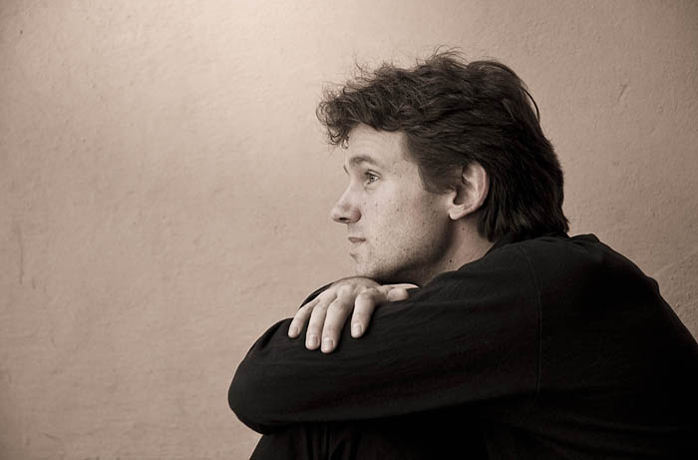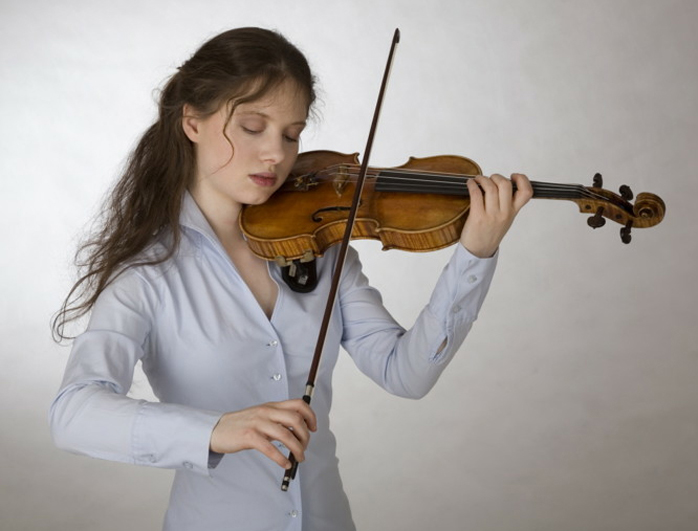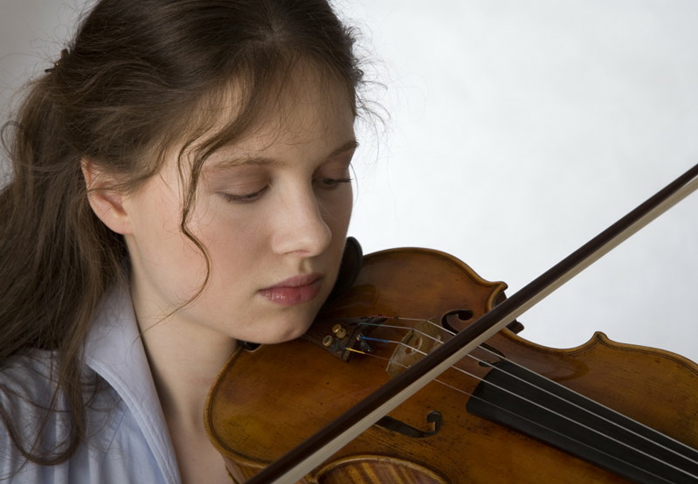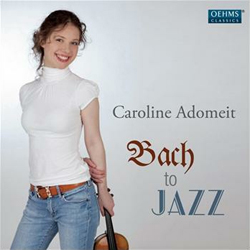 |
||||
 |
||||
|
||||
|
||||
 |
||||
The Bach Partita begins with an introductory Preludio followed by six dance numbers. Some tend to qualify Adomeit’s playing of these Baroque dances as modernistic probably because she has this keen sense of rhythm and pulse. I prefer to call it rustic. The mood she portrays has the country spirit of a simple-minded peasant or shepherdess. The swinging pulse is perhaps close to that of a modern Celtic fiddler but the tone is enriched with a sense of period or folk instrument of the time. Her focus is on the big picture and ‘dancing scene’ but doesn’t overlook the microdynamic range in the phrasing and detailing. The Romantic encores are even more carefree. She has a big technique that allows her to fire up the Sarasate Tarantella with flaming colors and accelerate through the fast pizzicatos with accuracy. Pianist Julian Riem demonstrates perfect partnership in this kind of expressive playing, even more so in the nomadic Csárdás. What comes after the encores is the really pleasant surprise. Adomeit and Riem exemplify seamless collaboration in the three transcriptions of folk melodies. Adomeit not only did the transcriptions herself but also showcases her sweet singing tone in the English ballad Scarborough Fair and the Belarussian folk song Kupalinka. Her double-stop melodic lines in the latter are absolutely lyrical and touching. Toss the Feathers is a Scottish reel that cries out for a virtuoso violin and piano duet or rather duel. The fast steps are skillfully imbued with pulsating vibratos that set your heartbeat on irregular patterns. |
||||
 |
||||
Two more transcriptions by Adomeit which won me over show quite different nationalistic flavors. Wenn die Sonja russisch tanzt was originally a Jewish song popularized by the Comedian Harmonists here recreated as a bittersweet Jewish wedding dance played by a fiddler and pianist on the roof. La Cumparsita doesn’t need any introduction except for a friendly reminder that the composer Gerardo Rodriguez was Uruguayan, not Argentinean. What I like about this Adomeit-Riem interpretation is their sheer elegance without over-exploited seductiveness. Last but not least the three Jazz tracks are all dance-beat Jazz. Percussionist Thomas Hastreiter joined in for a moody swing in Duke Ellington’s It Don’t Mean A Thing and a slow four-beat waltz in Bill Withers’ Aint’ No Sunshine. But it’s in Paul Desmond’s Take Five that the riveting rhythms really kicked up my JL Audio subwoofers. And Adomeit’s violin runs are saxy. Most jazz improvisations give me that drag-on feeling but not here where they are done just right within the well-balanced classical form. The interplay between violin and piano is wittingly charming. |
||||
|
||||
I am 24. My father's name is Gadd (he's British) and my mother’s Adomeit. So my proper name is Adomeit-Gadd. As you mentioned I usually drop the Gadd because it's easier to remember.Both my parents are musicians. However, they did not want me to become a musician/violinist too. They knew how much work it is and just wanted me to enjoy life. So it may sound a little weir, but I really had to fight to play the violin. In January 2011 I was asked to perform the Korngold concerto as a substitute for the original soloist who had an injury. I had only 3 weeks to learn the concerto which I didn't know... the videos are from that concert in February 2011. [I watched that video before I posed the question. It honestly didn’t feel like she just learned this concerto new. The nostalgic lyricism was absolutely heartfelt.] |
||||
 |
||||
I do listen to classical music of course but also Jazz and Pop depending on how I feel. I love Ella Fitzgerald, Benny Goodman, the Beatle, but also Klezmer (love Giora Feidman) and Eastern European, South American folk music as you know... It's difficult for me to say whether the system over here (Germany) is particularly "serious". I can only speak for myself. I was taught mainly by Russian teachers and Prof. Herman Krebbers from Amsterdam. As a child I went to the theatres, operas, operettas, musicals very often and loved even then very mixed repertoire from Peter Grimes to Madame Butterfly to Die Fledermaus. Perhaps that influenced me in some way? I remember when I was a child I loved listening to a recording of songs from around the world – Chinese, Mexican, Norwegian, Latin American songs and many others. And I loved dancing to them. |
||||
 |
||||
Who introduced me to Latin and Jazz? I heard a Tango performed by a guitarist and was immediately in love with it and decided to arrange it for the violin. As for Jazz I can't tell you when I first listened to Jazz music but it must have been very early as I "composed" a little "Bye Bye Blues", a solo violin piece for my primary school teacher (as farewell because I was going to grammar school) when I was about 9. Now that's a very good question and I am asking that myself regularly as I want to make sure that I am doing what I want to do as a musician. First of all, I can't remember a time when I didn't want to become a violinist. I couldn't imagine doing anything else. I would like to play to the best of my ability and always develop and improve as a violinist and musician. I am of the opinion that classical music is not just for an "elite" audience and that there are no borders in good music. So I am trying, both in my concerts and recordings, to reach out to people that ordinarily would not perhaps go to a classical concert or listen to a Bach partita. As I love so many very different styles of music, I would not like to be confined to be just playing one kind of music. I love the variety and would like to do more of that. |
||||
 |



